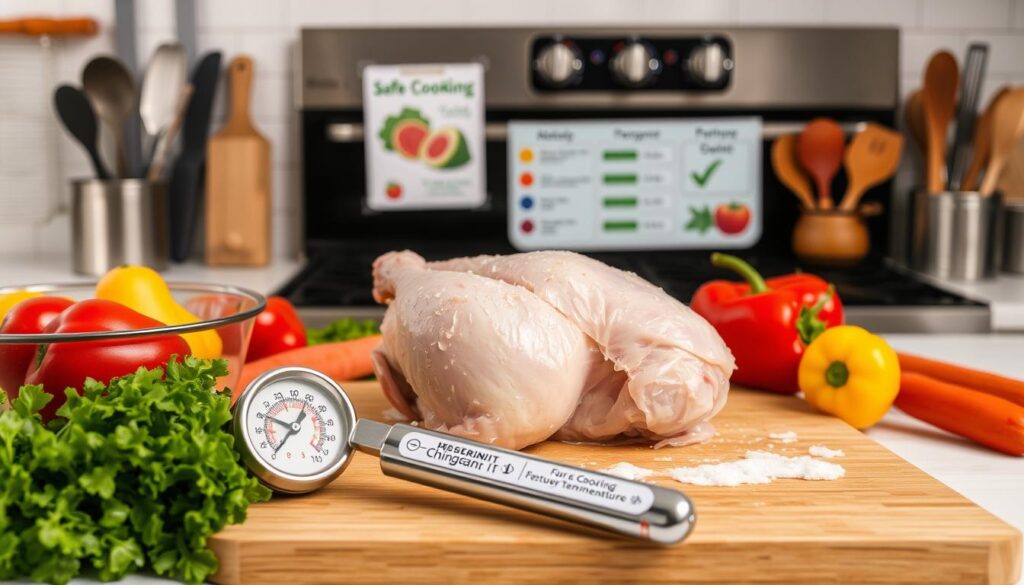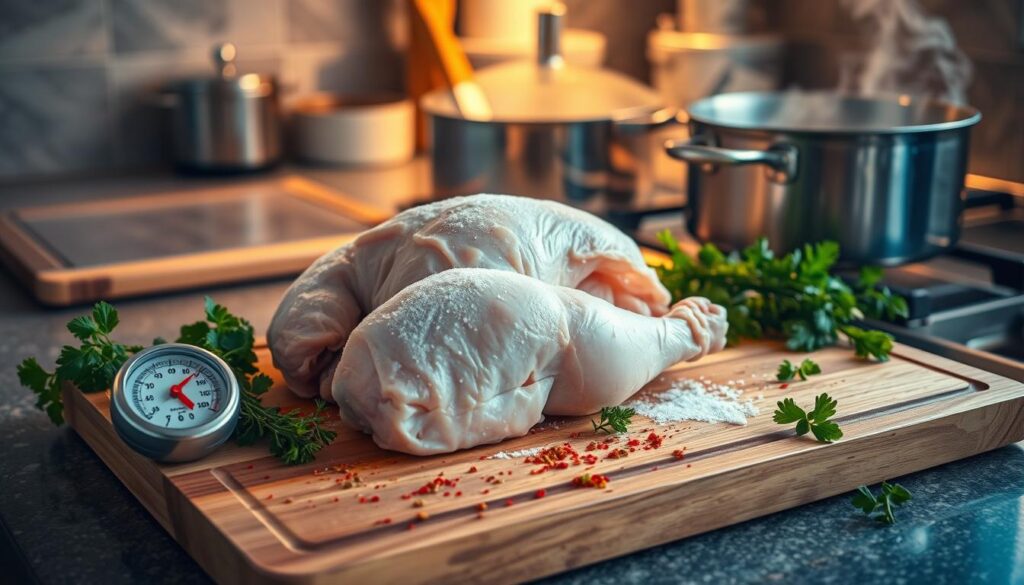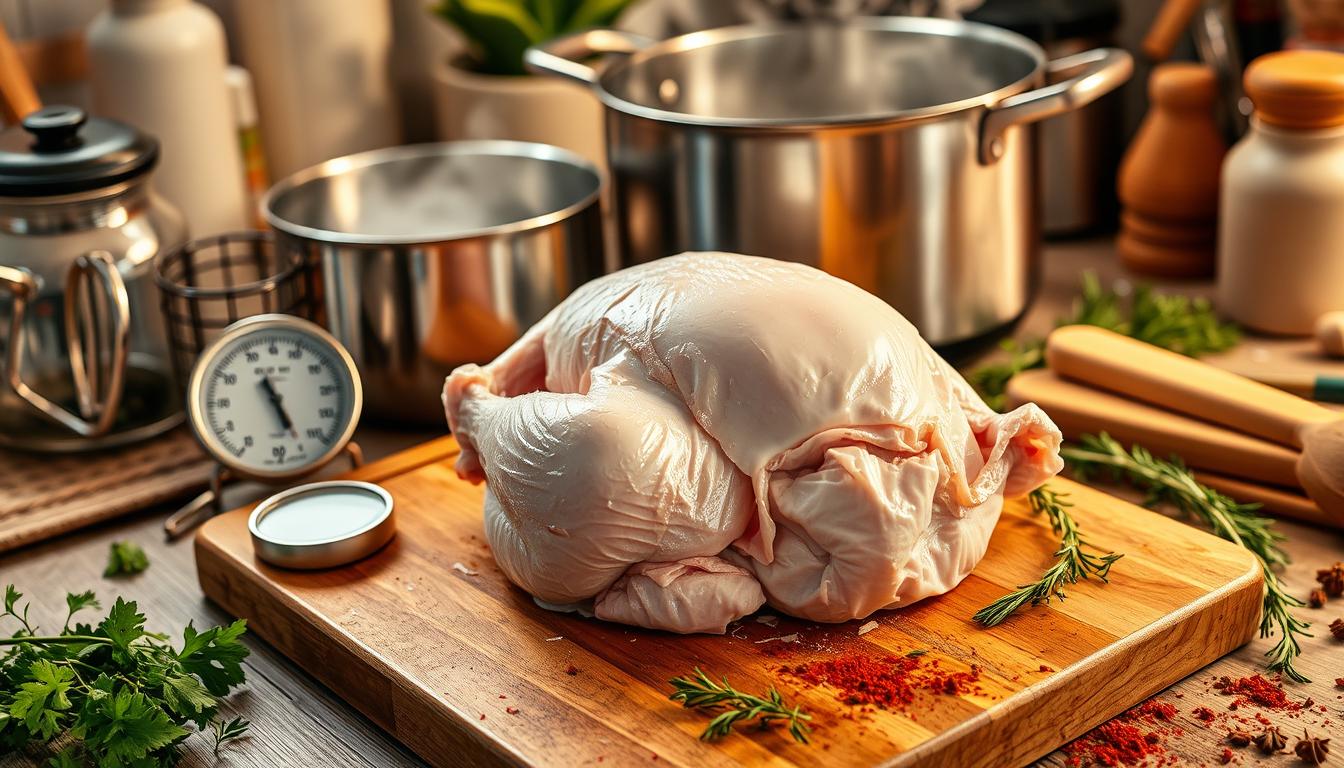Ever found yourself staring into the refrigerator, realizing your chicken is frozen solid and dinner time is near? You’re not alone. Cooking partially frozen chicken might seem daunting, but with the right techniques, it can be safe and convenient for busy home cooks.
The good news is that cooking frozen chicken is possible and can be just as tasty as thawed meat. Partially frozen chicken needs extra care to ensure food safety and taste. When cooking your chicken, adjust the time and temperature to cook it thoroughly and safely.
Understanding food safety for frozen chicken is key. The USDA says chicken can be cooked from frozen, but cooking time increases by about 50%. A chicken breast that takes 15 minutes when thawed might need 22 minutes from frozen.
Your main goal is to reach a safe internal temperature of 165°F. An instant-read thermometer is your best friend for ensuring your chicken is cooked perfectly and safely. Cooking partially frozen chicken is not just about convenience. It’s about keeping the highest food safety standards in your kitchen.
Understanding Partially Frozen Chicken Safety Basics
Cooking partially frozen chicken needs careful attention to food safety. Proper handling and preparation are key to avoid foodborne illnesses and enjoy a tasty meal.

When working with frozen poultry, knowing safe chicken cooking temperatures is vital. The USDA offers clear guidelines to help home cooks stay safe and enjoy their meals.
Key Food Safety Guidelines
- Always use a meat thermometer to check internal temperature
- Chicken must reach 165°F (74°C) to kill harmful bacteria
- Avoid cooking chicken at room temperature
- Thaw chicken in the refrigerator when possible
Temperature and Cooking Time Considerations
Frozen chicken takes about 50% longer to cook than thawed chicken. The danger zone for bacterial growth is between 40°F and 140°F. So, keeping proper temperatures is key.
| Chicken Type | Safe Internal Temperature | Cooking Time Adjustment |
|---|---|---|
| Whole Chicken | 165°F | 50% longer |
| Chicken Pieces | 165°F | 50% longer |
| Ground Chicken | 165°F | Immediate |
Recommended Cooking Practices
To ensure food safety for frozen chicken, always cook at a consistent temperature. Use a reliable meat thermometer. Avoid partial cooking or leaving chicken at room temperature for too long.
Can I cook chicken if it’s a little frozen?
Cooking chicken that’s a bit frozen is a common problem. But, you can do it safely and enjoy a tasty meal. Just follow some key guidelines to make sure it’s both safe and delicious.

The USDA has clear advice on cooking chicken that’s not fully thawed. You can cook it, but you must be careful to avoid food safety issues. Not all cooking methods are safe for partially frozen chicken.
- Recommended cooking methods for partially frozen chicken:
- Oven baking
- Stovetop cooking
Cooking times will be about 50% longer for frozen chicken. So, be patient and adjust your cooking plan.
| Cooking
Method |
Recommended for
Partially Frozen Chicken |
Safety
Considerations |
|---|---|---|
| Oven | Yes | Increase cooking time, ensure internal temperature reaches 165°F |
| Stovetop | Yes | Cook slowly, stir frequently |
| Slow Cooker | No | Unsafe – risk of bacterial growth |
| Microwave | No | Uneven cooking, possible bacterial risks |
When cooking frozen chicken, aim for an internal temperature of 165°F. Use a meat thermometer to check the thickest part of the meat. This step is key to killing bacteria and making the chicken safe to eat.
Pro tip: Try to thaw your chicken in the fridge before cooking. This makes cooking more even and lowers bacterial risk. Always put food safety first when cooking chicken.
Benefits of Cooking Frozen Chicken
Cooking frozen chicken is great for home cooks looking for easy and healthy meals. Frozen chicken meal prep is popular because it saves time and is convenient.
- Nutrient preservation through advanced freezing techniques
- Significant time savings for busy households
- Reduced food waste with portioned packaging
- Extended storage capabilities
Nutrient Retention in Frozen Chicken
Rapid freezing, like blast freezing, keeps chicken’s nutrients intact. Scientific research shows that protein, fat, and carbs stay mostly the same during freezing.
| Freezing Technique | Nutrient Preservation | Quality Impact |
|---|---|---|
| Blast Freezing | High Protein Retention | Minimal Cellular Damage |
| Vacuum Sealing | Prevents Oxidation | Extended Shelf Life |
| Sous Vide Preparation | Maximum Moisture Retention | Enhanced Flavor Preservation |
Time-Saving Advantages
Frozen chicken meal prep cuts down kitchen time. It turns frozen chicken into tasty meals fast, perfect for quick meals and busy lives.
Reduced Food Waste
Frozen chicken helps reduce food waste. Vacuum-sealed packaging stops freezer burn and lets you portion meals exactly. This way, you only thaw what you need.
Best Methods for Cooking Partially Frozen Chicken
Cooking frozen chicken needs careful attention for safety and taste. When using partially frozen chicken, adjust your cooking methods. This ensures it’s cooked thoroughly and safely.
There are several ways to make frozen chicken into a delicious meal. Here are the top methods:
- Oven Baking: The most reliable method for cooking frozen chicken
- Stovetop cooking for smaller chicken pieces
- Instant Pot for quick preparation
- Air fryer for crispy exterior
Remember, cooking frozen chicken takes about 50% longer than fresh chicken. The safe chicken cooking temperatures are the same. You must reach an internal temperature of 165 degrees Fahrenheit to kill harmful bacteria.
| Chicken Type | Oven Cooking Time | Stovetop Cooking Time |
|---|---|---|
| Boneless Chicken Breast (4-6 oz) | 30-45 minutes | 38-45 minutes |
| Bone-in Chicken Breast (6-8 oz) | 45-60 minutes | 53-68 minutes |
| Chicken Thighs (4-8 oz) | 60-75 minutes | 60-75 minutes |
Pro tip for cooking frozen chicken: Always use a meat thermometer. This confirms you’ve reached the safe internal temperature of 165°F. It makes sure your chicken is fully cooked and safe to eat, avoiding foodborne illnesses.
Recommended Cooking Times and Temperatures
Cooking frozen chicken needs careful attention to cooking times and temperatures. Knowing the right methods helps you make tasty and safe meals fast. Proper cooking methods are key to fully cooking your chicken.
Oven-Baking Guidelines
For oven-baking frozen chicken, follow these guidelines:
- Preheat oven to 375°F (190°C)
- Boneless chicken breasts: 45-60 minutes
- Bone-in chicken pieces: 60-90 minutes
- Whole chicken: 1 3/4 to 2 1/4 hours
Stovetop Cooking Instructions
Stovetop cooking needs steady heat and watching closely. Here’s a quick guide:
| Chicken Cut | Cooking Time | Temperature |
|---|---|---|
| Boneless Breast | 9-11 minutes per side | Medium-high heat |
| Chicken Thighs | 7-8 minutes per side | Medium heat |
Using a Meat Thermometer
A meat thermometer is vital for safe chicken cooking temperatures. Always check that the internal temperature reaches 165°F (74°C). Put the thermometer into the thickest part of the meat, away from bone, for an accurate reading.
- Breast: Check at 165°F
- Thighs and legs: Check at 175°F
- Whole chicken: 165°F in breast and thigh
Let your chicken rest for 10-15 minutes after cooking. This lets juices spread, making your meal moist and flavorful.
Common Mistakes to Avoid When Cooking Frozen Chicken
Cooking frozen chicken needs careful attention to food safety and right techniques. Many home cooks make big mistakes that can ruin both the taste and safety of their meals.
Here are the most common mistakes to avoid when cooking frozen chicken:
- Avoid Using Slow Cookers: Never try to cook frozen chicken in a slow cooker. These appliances can’t heat the meat fast enough to stop bacterial growth, which is a big food safety risk.
- Skipping Temperature Checks: Always use a meat thermometer to make sure the internal temperature hits 165 degrees Fahrenheit. This is key for killing harmful bacteria when cooking frozen chicken.
- Incorrect Thawing Methods: Don’t thaw chicken at room temperature or with warm water. The safest ways are refrigerator thawing or cold water thawing.
- Uneven Cooking: Cooking frozen chicken takes longer and needs careful watching to avoid overcooking the surface while keeping the center raw.
When preparing food safety for frozen chicken, remember these important guidelines:
- Always separate raw chicken from other foods to prevent cross-contamination
- Wash hands thoroughly before and after handling raw chicken
- Use separate cutting boards for raw meats
- Cook chicken right after thawing
Cooking frozen chicken right means knowing the right techniques and avoiding common mistakes. By avoiding these errors, you can make tasty, safe meals that everyone will love.
Tips for Achieving Juicy and Tender Results
Cooking frozen chicken can be tough, but the right techniques make it delicious. Learning to season and keep moisture is key. It turns frozen chicken into a tasty meal.
Mastering Seasoning for Frozen Chicken
Seasoning frozen chicken needs a smart plan. Start by searing the first side to lock in flavors. This method stops seasonings from burning and adds rich taste.
- Use dry rubs that stick well to partially frozen surfaces
- Apply marinades after initial cooking to prevent burning
- Consider Greek yogurt-based marinades for extra tenderness
Moisture Retention Techniques
To keep chicken juicy when cooking from frozen, pay close attention. Cook slowly and keep moisture inside.
| Technique | Moisture Retention Method |
|---|---|
| Brining | Soak chicken in saltwater solution for 24 hours |
| Slow Cooking | Use low heat with liquid cover |
| Basting | Regularly coat chicken with its own juices |
Pro tip for cooking frozen chicken: Always use a meat thermometer. Make sure the chicken’s internal temperature hits 165°F (74°C). This ensures safety and keeps the chicken moist.
Storage and Freezing Guidelines
Learning how to freeze chicken is key for keeping it safe and tasty. Knowing how to store it right can make your chicken last for months.
For safe frozen chicken, follow important storage rules. The USDA says to freeze chicken at 0°F or below. This stops bacteria from growing and keeps the chicken at its best.
- Freeze chicken before its use-by date
- Use airtight, freezer-safe containers
- Label packages with the date of freezing
- Store chicken for maximum 3-6 months
Thawing chicken needs careful steps to avoid food poisoning. The best ways are:
- Refrigerator thawing (recommended)
- Cold water thawing
- Microwave thawing
Pro tip: Never thaw chicken at room temperature, as this creates a breeding ground for harmful bacteria.
When you need to refreeze chicken, follow strict rules. You can refreeze chicken thawed in the fridge. But chicken thawed in cold water or the microwave must be cooked right away and can’t be refrozen.
Watch out for signs of bad frozen chicken. Look for odd smells, color changes, or ice crystals. If you’re unsure, it’s best to throw it away for safety’s sake.
Preparing Quick and Healthy Meals with Frozen Chicken
Frozen chicken is a great choice for those who are short on time. It makes meal prep easy and fast. You can whip up tasty, healthy dishes in no time.
Creative Recipe Ideas
Using frozen chicken lets you explore new flavors. It’s easy to turn it into tasty meals. Here are some quick ideas:
- Instant Pot chicken stir-fries
- One-pan chicken and vegetable casseroles
- Quick chicken soups
- Shredded chicken for tacos or salads
Time-Saving Kitchen Hacks
Streamline your frozen chicken meal prep with these tips:
| Technique | Time Saved |
|---|---|
| Batch cooking frozen chicken | Up to 45 minutes per week |
| Instant Pot cooking | 30 minutes total preparation |
| Pre-seasoning frozen chicken | 10-15 minutes |
Remember, always cook frozen chicken to 165°F for safety. These tips will help you make delicious meals quickly. You’ll save time and enjoy every bite.
Conclusion
Learning to cook frozen chicken is all about safety. When you wonder if you can cook chicken that’s a bit frozen, remember safety first. The right temperature and method are key. This way, you can make tasty meals from frozen chicken.
You now know how to handle and cook partially frozen chicken safely. The tips you’ve learned make cooking frozen chicken easy. Try this creamy lemon garlic butter chicken recipe to use your new skills.
Always keep food safety in mind. Check the chicken’s internal temperature and use the right cooking methods. Stay away from temperatures between 40° F and 140° F. With time, you’ll cook chicken safely and enjoy it too.
Now you’re ready to cook frozen chicken with confidence. Remember to thaw safely, cook well, and enjoy healthy meals. Your health and taste will thank you.
FAQ
Is it safe to cook chicken that is partially frozen?
Yes, you can cook chicken that’s partially frozen. But, make sure it reaches 165°F (74°C) inside. Adjust cooking time and use methods that heat evenly to kill bacteria and keep food safe.
How much longer does it take to cook partially frozen chicken?
Cooking time for partially frozen chicken is about 50% longer than thawed chicken. For example, if thawed chicken cooks in 30 minutes, frozen chicken takes 45-50 minutes.
What cooking methods work best for partially frozen chicken?
Oven-baking and slow cooking are best for partially frozen chicken. They ensure even heating and prevent uneven cooking. Avoid deep-frying or grilling, as they can leave parts undercooked.
Do I need to use a meat thermometer when cooking partially frozen chicken?
Absolutely. A meat thermometer is key for food safety. Always check the internal temperature reaches 165°F (74°C) at the thickest part to kill harmful bacteria.
Can I refreeze chicken after cooking it from a partially frozen state?
Yes, you can refreeze cooked chicken that was frozen before. But, each freeze-thaw cycle can lower quality and moisture. It’s best to use it within 2-3 months.
What are the risks of cooking chicken that is stil frozen?
Risks include uneven cooking, bacterial growth, and undercooked meat. Always cook thoroughly and use a meat thermometer to ensure safe temperatures.
How can I quickly thaw chicken if I forget to take it out of the freezer?
Safe quick thawing methods are the refrigerator, cold water, or microwave defrost. The refrigerator is slowest but safest. Cold water takes about an hour, and microwave defrosting is best for immediate cooking.
Are there any nutrition differences between fresh and frozen chicken?
There’s little nutritional difference between fresh and frozen chicken when frozen right. Freezing preserves nutrients and is great for keeping nutritional value. Just freeze properly and avoid repeated freezing and thawing.
What seasoning tips work best for cooking partially frozen chicken?
Use marinades or dry rubs with salt and herbs to penetrate the meat. Consider brining or adding moisture-rich ingredients to prevent drying out during cooking.
How long can I store chicken in the freezer?
Raw chicken can be frozen for up to 9 months, and cooked chicken for 2-6 months. Use airtight containers or vacuum-sealed bags to prevent freezer burn and keep quality.

